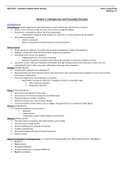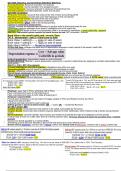Digitalisering
1. Introductie & AI sociale relaties - Stef Aupers
Literatuur
- A social science perspective on artificial intelligence (Lindgren en Johnny Holmstrom)
͐ Onderzoek naar AI in sociale wetenschappen
͐ 4 sleutelcomponenten:
~ Bestuderen van mens- machine interactie
~ Technologische en menselijke actoren gelijkwaardig behandelen
~ Breder discours rond de sociale constructie van AI
~ Kritische reflectie op impact van AI, algoritmes en dataverzameling
- The new frontier in communication research why we should study social robots (John Peter)
͐ Social robots zijn popular vor interactie met mensen
͐ Ze dagen traditionele opvattingen over medium en media uit
͐ Opkomst van sociale robots daagt 3 paradigma’s uit:
~ Opvattingen over het medium: sociale robots veranderen traditionele ideeën
over wat het medium is
~ Opvattingen over communicatiepartner: aanwezigheid van robots zet
vraagtekens bij hoe we communicatiepartners definiëren
~ Grenzen van communicatie: sociale robots dwingen onderzoekers na te
denken over grenzen van communicatie
͐ Sociale robots verdienen meer aandacht, moeten centralere positie krijgen in
communicatieonderzoek
- Post human encounters: humanising the technological other in videogames (Coanda en Stef
Aupers)
͐ Alexa, chatbots, videogamekarakters -> ontwikkeld om aspecten van mens na te
bootsen
͐ Onderzoek naar ervaring van mens met dergelijke technologieën onderontwikkeld
͐ Hoe en waarom spelers niet speelbare videogamekarakters humaniseren
͐ 21 online en offline interviews -> anlyse: verschillende manieren waarop spelers niet
speelbare videogamekarakters (NPCS) humaniseren en hoe dit van invloed is op hun
offline relaties
͐ Bevindingen:
~ Kenmerken van het humaniseren: emoties, imperfecties en emotionele
uitbarstingen van NPCs belangrijk
~ Humaniserende interactiviteit: interactie is belangrijk, intieme interactie
versterkt relatie tussen spelers
~ Impact menselijke relaties
1.1 Digitalisering
Fase 1 : Personal computer 1975-…
- Hiervoor enorme computers, maar enkel voor grote bedrijven
- 1975: start digitalisering, eerste Apple computer ( Steve Jobs, Wozniak)
- Voor eerste keer krijgt digitale media plek in samenleving
- “Bringing Computer Power to the People” (Steve Jobs, Wozniak) = “mensen zelfstandig laten werken”
- =macht gevne aan bevolking
Fase 2: Internet en sociale media 2004-…
1
, Digitalisering
- Begon als netwerk om computers met elkaar te verbinden
- 2004: sociale media- in contact met anderen
- Individueel gebruik van digitale technologie -> sociaal contact opnemen
- Facebook (Zuckerberg) : “making the world more open and connected”
Fase 3: Artificiële intelligentie 1955-…
Weak AI <-> Strong AI
- Weak: simpel algoritme, niet veel meer dan 1 specifieke taak ( computer, gsm,..)
- Strong: complex, superieur; in staat alle verschillenden taken van mens na te bootsen (hier zijn we
zelf nog niet) vb. machine die eigen film kan maken
Top down <-> Bottom up
- Top down: computer voert uit wat het moet doen, wat is ingevoerd
- Bottom up: zelflerend algoritme, leert elke keer als je iets invoert, complex
- John McCarthy & Marvin Minsky -> Introductie in Darthmouth Conference 1955
- “making a machine behave in ways that would be called intelligent if a human were so behaving”
- Simulatie van menselijke rationaliteit
Ai in het dagelijks leven:
- Likes: blijven zelfde info die je leuk vindt tonen
- Beurs
- Chatgpt
- Overheid maakt gebruik van algoritme -> veiligheid (hoe veiliger, hoe minder privacy)
Ai en morele paniek: bij elke nieuwe media paniek, “AI zo slim – controle overnemen?”
1.1 Ai : een sociaal wetenschappelijk perspectief
Goed of slecht?
Als onderzoeker moet je neutraal zijn! (methodisch agnosticisme)
Stelling: ‘Ai ondermijnt het onderscheid tussen, mens en machine; subject en object; organisme en
mechanisme’
Zijn Ai machines intelligent? Zijn machines heel intelligent of zijn mensen toch niet zo bijzonder als
we dachten?
-> De Turing Test (1950) : 8 min lang gesprek mens en computer – merk mens of het een machine is , of
denkt hij dat dat het een persoon is waar hij tegen praat?
Ai ontwikkeld zich, dat we in een gesprek niet kunnen merken of het een mens of robot is
1.1 Ai: uitdagingen voor geesteswetenschappen
Voorbij het antropocentrisch paradigma
- Mens niet meer centraal
- Meer aandacht aan aarde, dieren en andere entiteiten die niet menselijk zijn ( niet geboren) maar wel
intelligent zijn
- Filosofie: van humanisme -> post humanisme (mens niet centraal) vb robots, cyborg en post humane
entiteiten
1.1 Ai uitdagingen voor communicatiewetenschappen
The new frontier in communication research: why we should study social robots ( Peter & Kuhne, 2018):
2
, Digitalisering
- Ai creëert nieuwe communicatie: is niet meer enkel het medium waar we via spreken -> waarmee we
spreken
- “challenges three paradigmatic assumptions in communication research..”:
͐ About the medium
͐ The communication partner: Ai is communicatiepartner
͐ The boundries of communication
1.1 Ai uitdagingen voor sociale wetenschappen
Sociologie: vooral relatie tussen mensen
-> Bruno Latour: ook naar relatie met dingen zien; subjecten en objecten
“objects have agency too” = actor network theory
<-> social network analysis
- Ai, is net als de mens een “social actor” (Lindgren en Holmstrom, 2020)
- Een empirische exploratieve, kwalitatieve casestudie naar relatie tussen gamers en NPC in games
(Coanda en Aupers, 2021)
͐ Personages in game betekenen iets voor mensen
͐ “how and why players humanize non playable videogame characters (NPC’s)”
͐ Weak Ai
͐ Aantrekkingskracht: morele ambiguiteit (niet goed/ slecht), kunnen emoties tonen (liefde,
haat,..), imperfecties van NPC, interacties,…
͐ Implicatie in het echte leven (ruzie met echte partner)
͐ Sociale, romantische relaties met NPC’s
3
1. Introductie & AI sociale relaties - Stef Aupers
Literatuur
- A social science perspective on artificial intelligence (Lindgren en Johnny Holmstrom)
͐ Onderzoek naar AI in sociale wetenschappen
͐ 4 sleutelcomponenten:
~ Bestuderen van mens- machine interactie
~ Technologische en menselijke actoren gelijkwaardig behandelen
~ Breder discours rond de sociale constructie van AI
~ Kritische reflectie op impact van AI, algoritmes en dataverzameling
- The new frontier in communication research why we should study social robots (John Peter)
͐ Social robots zijn popular vor interactie met mensen
͐ Ze dagen traditionele opvattingen over medium en media uit
͐ Opkomst van sociale robots daagt 3 paradigma’s uit:
~ Opvattingen over het medium: sociale robots veranderen traditionele ideeën
over wat het medium is
~ Opvattingen over communicatiepartner: aanwezigheid van robots zet
vraagtekens bij hoe we communicatiepartners definiëren
~ Grenzen van communicatie: sociale robots dwingen onderzoekers na te
denken over grenzen van communicatie
͐ Sociale robots verdienen meer aandacht, moeten centralere positie krijgen in
communicatieonderzoek
- Post human encounters: humanising the technological other in videogames (Coanda en Stef
Aupers)
͐ Alexa, chatbots, videogamekarakters -> ontwikkeld om aspecten van mens na te
bootsen
͐ Onderzoek naar ervaring van mens met dergelijke technologieën onderontwikkeld
͐ Hoe en waarom spelers niet speelbare videogamekarakters humaniseren
͐ 21 online en offline interviews -> anlyse: verschillende manieren waarop spelers niet
speelbare videogamekarakters (NPCS) humaniseren en hoe dit van invloed is op hun
offline relaties
͐ Bevindingen:
~ Kenmerken van het humaniseren: emoties, imperfecties en emotionele
uitbarstingen van NPCs belangrijk
~ Humaniserende interactiviteit: interactie is belangrijk, intieme interactie
versterkt relatie tussen spelers
~ Impact menselijke relaties
1.1 Digitalisering
Fase 1 : Personal computer 1975-…
- Hiervoor enorme computers, maar enkel voor grote bedrijven
- 1975: start digitalisering, eerste Apple computer ( Steve Jobs, Wozniak)
- Voor eerste keer krijgt digitale media plek in samenleving
- “Bringing Computer Power to the People” (Steve Jobs, Wozniak) = “mensen zelfstandig laten werken”
- =macht gevne aan bevolking
Fase 2: Internet en sociale media 2004-…
1
, Digitalisering
- Begon als netwerk om computers met elkaar te verbinden
- 2004: sociale media- in contact met anderen
- Individueel gebruik van digitale technologie -> sociaal contact opnemen
- Facebook (Zuckerberg) : “making the world more open and connected”
Fase 3: Artificiële intelligentie 1955-…
Weak AI <-> Strong AI
- Weak: simpel algoritme, niet veel meer dan 1 specifieke taak ( computer, gsm,..)
- Strong: complex, superieur; in staat alle verschillenden taken van mens na te bootsen (hier zijn we
zelf nog niet) vb. machine die eigen film kan maken
Top down <-> Bottom up
- Top down: computer voert uit wat het moet doen, wat is ingevoerd
- Bottom up: zelflerend algoritme, leert elke keer als je iets invoert, complex
- John McCarthy & Marvin Minsky -> Introductie in Darthmouth Conference 1955
- “making a machine behave in ways that would be called intelligent if a human were so behaving”
- Simulatie van menselijke rationaliteit
Ai in het dagelijks leven:
- Likes: blijven zelfde info die je leuk vindt tonen
- Beurs
- Chatgpt
- Overheid maakt gebruik van algoritme -> veiligheid (hoe veiliger, hoe minder privacy)
Ai en morele paniek: bij elke nieuwe media paniek, “AI zo slim – controle overnemen?”
1.1 Ai : een sociaal wetenschappelijk perspectief
Goed of slecht?
Als onderzoeker moet je neutraal zijn! (methodisch agnosticisme)
Stelling: ‘Ai ondermijnt het onderscheid tussen, mens en machine; subject en object; organisme en
mechanisme’
Zijn Ai machines intelligent? Zijn machines heel intelligent of zijn mensen toch niet zo bijzonder als
we dachten?
-> De Turing Test (1950) : 8 min lang gesprek mens en computer – merk mens of het een machine is , of
denkt hij dat dat het een persoon is waar hij tegen praat?
Ai ontwikkeld zich, dat we in een gesprek niet kunnen merken of het een mens of robot is
1.1 Ai: uitdagingen voor geesteswetenschappen
Voorbij het antropocentrisch paradigma
- Mens niet meer centraal
- Meer aandacht aan aarde, dieren en andere entiteiten die niet menselijk zijn ( niet geboren) maar wel
intelligent zijn
- Filosofie: van humanisme -> post humanisme (mens niet centraal) vb robots, cyborg en post humane
entiteiten
1.1 Ai uitdagingen voor communicatiewetenschappen
The new frontier in communication research: why we should study social robots ( Peter & Kuhne, 2018):
2
, Digitalisering
- Ai creëert nieuwe communicatie: is niet meer enkel het medium waar we via spreken -> waarmee we
spreken
- “challenges three paradigmatic assumptions in communication research..”:
͐ About the medium
͐ The communication partner: Ai is communicatiepartner
͐ The boundries of communication
1.1 Ai uitdagingen voor sociale wetenschappen
Sociologie: vooral relatie tussen mensen
-> Bruno Latour: ook naar relatie met dingen zien; subjecten en objecten
“objects have agency too” = actor network theory
<-> social network analysis
- Ai, is net als de mens een “social actor” (Lindgren en Holmstrom, 2020)
- Een empirische exploratieve, kwalitatieve casestudie naar relatie tussen gamers en NPC in games
(Coanda en Aupers, 2021)
͐ Personages in game betekenen iets voor mensen
͐ “how and why players humanize non playable videogame characters (NPC’s)”
͐ Weak Ai
͐ Aantrekkingskracht: morele ambiguiteit (niet goed/ slecht), kunnen emoties tonen (liefde,
haat,..), imperfecties van NPC, interacties,…
͐ Implicatie in het echte leven (ruzie met echte partner)
͐ Sociale, romantische relaties met NPC’s
3










